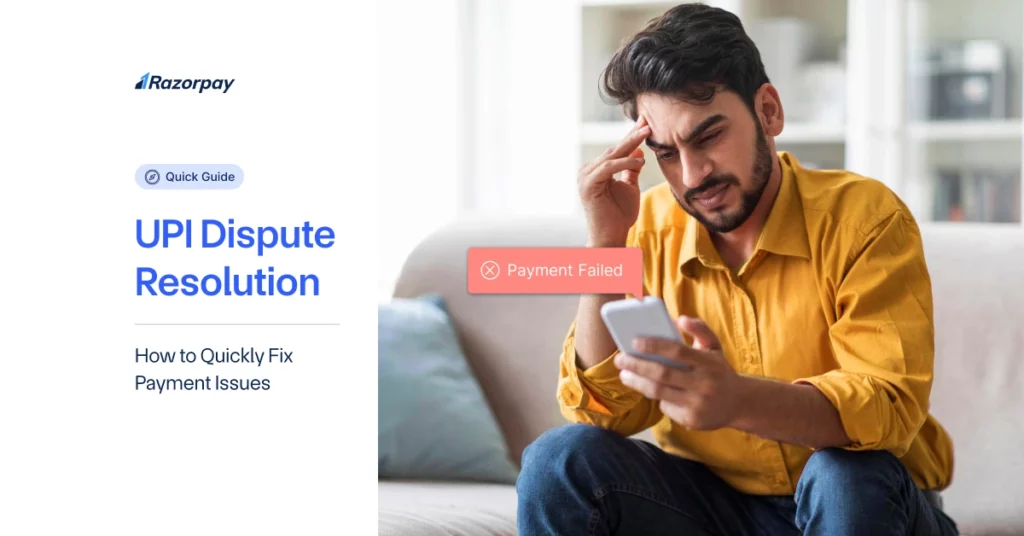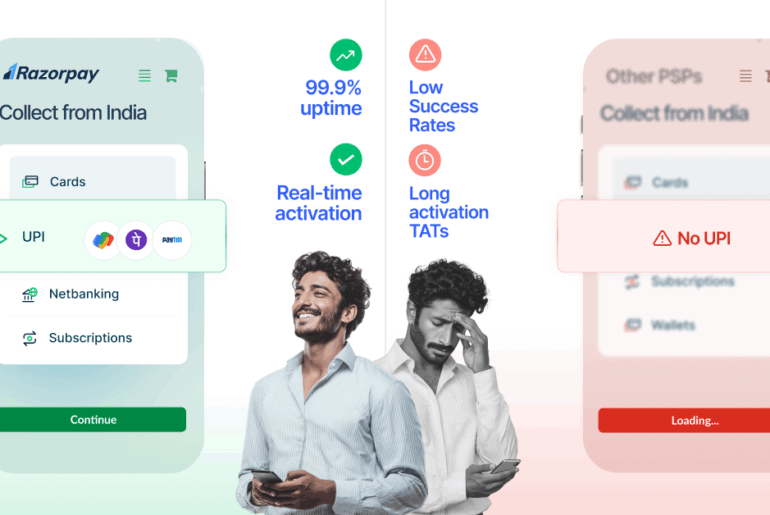In the rapidly evolving landscape of digital payments, the Unified Payments Interface (UPI) has emerged as a game-changer. With its convenience and speed, UPI has revolutionised the way people transact in India. However, as with any financial system, disputes and issues can arise. The National Payments Corporation of India (NPCI) has established a robust UPI dispute redressal mechanism to address these concerns effectively.
Table of Contents
What is the UPI Dispute Redressal Mechanism?
The UPI dispute redressal mechanism is a comprehensive framework designed by NPCI to handle and resolve issues that users may encounter during UPI transactions, including wrong UPI transactions. This mechanism ensures that users have a reliable and efficient means to address their concerns, fostering trust and confidence in the UPI platform.
Common Issues in UPI Transactions
Despite the convenience and security measures in place, users may occasionally face issues with their UPI transactions. Some common disputes include:
- Failed transactions
- Money debited but not credited to the recipient
- Unauthorised or fraudulent transactions
- Double debiting of funds
- Incorrect beneficiary details
These issues can lead to frustration and inconvenience for users, highlighting the importance of a robust dispute redressal mechanism.
Related Read: UPI Payment Failed? Here’s What You Can Do
Steps to Raise a UPI Dispute
If you encounter an issue with your UPI transaction, follow these steps to initiate a dispute:
1. Using the UPI App:
Open your UPI app (like Google Pay, PhonePe, or Paytm), navigate to your transaction history, select the problematic transaction, and choose the option to report an issue.
2. Contacting Customer Support:
Alternatively, you can reach out to customer support through the app’s help section or by calling the NPCI helpline at 1800-120-1740 for direct assistance.
3. Information Required:
When filing a complaint, be prepared to provide your registered mobile number, email address, transaction date, and details of the issue to facilitate a quick resolution.
NPCI’s UPI Dispute Resolution Mechanism
The NPCI is the governing authority behind the Unified Payments Interface (UPI), which is crucial in establishing and maintaining a robust dispute resolution mechanism. This framework is designed to address issues users may encounter during UPI transactions, such as failed payments or unauthorised debits, ensuring a reliable digital payment experience.
NPCI’s dispute resolution mechanism is structured to facilitate a systematic approach to handling complaints. Users can report issues through UPI-enabled apps, which first notify the respective banks involved in the transaction. If the bank cannot resolve the dispute, it is escalated to NPCI for further investigation. The process emphasises transparency and efficiency, with defined timelines for resolving different types of disputes.
To ensure quick resolutions, NPCI collaborates closely with banks and payment service providers. NPCI minimises delays and fosters effective communication among all parties involved by providing standardised guidelines and a centralised framework. This collaborative effort enhances user trust in the UPI system by addressing disputes promptly and fairly.
How NPCI’s UPI Dispute Redressal Mechanism Works
The UPI redressal mechanism follows a systematic, multi-stage process to resolve disputes effectively:
1. Initiate a Dispute:
- Users raise a dispute through their UPI app when an issue is encountered.
- The bank or payment provider linked to the user’s account is the first point of contact for addressing the complaint.
2. Notification to Your Bank:
- Upon receiving the dispute request, the bank or payment provider initiates an investigation.
- They gather relevant information and communicate with the parties involved to understand the issue.
3. Investigation and Resolution Process:
- The bank or payment provider analyses the transaction details and conducts a thorough investigation.
- They work towards resolving the dispute based on the findings and in accordance with NPCI guidelines.
4. User Communication and Updates:
- Throughout the process, the user receives regular updates on the status of their dispute.
- This transparency ensures that users are informed about the progress and any actions taken.
5. Escalation and Appeal Process:
- If the dispute remains unresolved at the bank or payment provider level, it can be escalated to NPCI for further examination.
- NPCI reviews the case and works towards a fair resolution, considering all the evidence and parties involved.
UPI Dispute Resolution Timeline
NPCI has established specific timelines for resolving different types of UPI disputes to ensure prompt action and minimise inconvenience to users:
Dispute Type |
Resolution Timeline |
|
Failed transactions |
Auto-reversal within 1-3 working days |
|
Unauthorised transactions |
Limited user liability if reported within 3 days |
|
Incorrect beneficiary |
Investigation and resolution within 5-7 working days |
|
Fraudulent transactions |
Investigation and resolution within 10-15 working days |
These timelines serve as a guideline, and the actual resolution time may vary depending on the complexity of the case and the cooperation of all parties involved.
Importance of a Dispute Redressal System in UPI
A well-defined dispute redressal mechanism is essential for building trust and confidence in the UPI ecosystem. It assures users that their concerns will be addressed promptly and fairly, encouraging greater adoption of digital payments.
This system also protects consumers from fraud and transaction errors by allowing them to report issues like unauthorised transactions. Ensuring the swift rectification of errors safeguards users’ financial interests and enhances their confidence in the UPI platform.
Additionally, an effective dispute-resolution mechanism ensures a smooth user experience. With real-time updates and transparent tracking of disputes, users remain informed throughout the process, which contributes to the reliability and accessibility of UPI services.
Tips for Preventing UPI Disputes
While the dispute redressal mechanism is there to help you, it’s always better to take proactive measures to prevent issues from arising in the first place. Here are some tips to minimise the occurrence of UPI disputes:
1. Double-check everything:
- Before confirming a transaction, carefully review the beneficiary details, amount, and other relevant information.
- Verify that the UPI ID or mobile number entered is correct to avoid sending money to the wrong recipient.
2. Keep your UPI app updated:
- Regularly update your UPI app to ensure you have the latest security features and bug fixes.
- Updated apps are less vulnerable to UPI fraud and security breaches.
3. Secrecy is vital:
- Never share your UPI PIN, password, or OTP with anyone, even if they claim to be from your bank or a legitimate organisation.
- Remember that banks and payment providers will never ask for your sensitive information over the phone or through unsolicited messages.
UPI Dispute Redressal Mechanism vs Traditional Banking Dispute Process
The UPI redressal mechanism offers several advantages over the traditional banking dispute process. Here’s the comparison between the UPI Dispute Redressal Mechanism and the Traditional Banking Dispute Process presented in a table format:
Aspect |
UPI Dispute Redressal |
Traditional Banking Dispute |
|
Speed |
Faster resolution, with specific timelines for each dispute type (e.g., auto-reversal within 1-3 working days). |
Longer process, often taking weeks or months to resolve. |
|
Convenience |
Disputes can be raised directly through the UPI app. |
Requires visiting the bank branch or contacting customer support. |
|
Process |
Streamlined and standardised across all UPI participants. |
Varies from bank to bank, leading to inconsistencies in handling disputes. |
|
Transparency |
Regular updates are provided to users throughout the process. |
Limited visibility and communication during the process. |
Real-Life Example of a UPI Dispute and Its Resolution
Let’s consider a real-life scenario to illustrate how the UPI dispute redressal mechanism works:
Rahul, an avid online shopper, made a purchase using his UPI app. However, despite the amount being debited from his account, the merchant claimed they didn’t receive the payment. Rahul immediately raised a dispute through his UPI app, providing the transaction details and a screenshot of the debit message.
The bank associated with Rahul’s UPI account promptly acknowledged the dispute and initiated an investigation. They reached out to the merchant’s bank to verify the transaction status. Upon confirmation that the merchant had indeed not received the funds, Rahul’s bank reversed the transaction and credited the amount back to his account within 3 working days.
Throughout the process, Rahul received timely updates from his bank regarding the status of the dispute. The swift resolution and transparent communication reinforced Rahul’s trust in the UPI system and its dispute redressal mechanism.
This example demonstrates how the UPI dispute redressal mechanism works efficiently to address user concerns and maintain the integrity of digital transactions.
Conclusion
The UPI dispute redressal mechanism is a vital safeguard that empowers users in the digital payment ecosystem. Providing a reliable and efficient channel to address transaction concerns and issues enhances the overall user experience, and fosters trust in UPI.
As the popularity of UPI continues to soar, understanding and utilising the dispute redressal mechanism becomes increasingly essential. Familiarising yourself with the process, your rights, and your responsibilities enables you to navigate the digital payment landscape confidently and securely.
Remember, prevention is always better than cure. By following best practices and staying vigilant, you can minimise the occurrence of UPI disputes and enjoy the convenience and benefits of digital transactions without compromising your financial well-being.
Frequently Asked Questions (FAQs):
1. How to check the UPI dispute redressal mechanism status?
You can check the status of your UPI dispute by logging into your UPI app and navigating to the transaction history section. Look for the disputed transaction and check the status update provided. Alternatively, you can contact your bank’s customer support for more information.
2. How long does it take to resolve a UPI dispute?
The resolution time for a UPI dispute depends on the type of issue and the complexity of the case. NPCI has established specific timelines for different dispute types, ranging from 1-3 working days for failed transactions to 10-15 working days for fraudulent transactions. However, the actual resolution time may vary based on the circumstances.
3. What steps are involved in the UPI dispute resolution process?
The UPI dispute resolution process involves the following steps:
-
Initiating a dispute through the UPI app
-
Notification to the user’s bank or payment provider
-
Investigation and resolution by the bank or payment provider
-
Regular communication and updates to the user
-
Escalation to NPCI if the dispute remains unresolved at the bank level
4. Is there any fee for raising a UPI dispute?
No, there is no fee for raising a UPI dispute. The dispute redressal mechanism is a free service provided by NPCI and the participating banks and payment providers to ensure a smooth and secure user experience. However, it’s important to raise disputes only for genuine issues and not to misuse the system.


